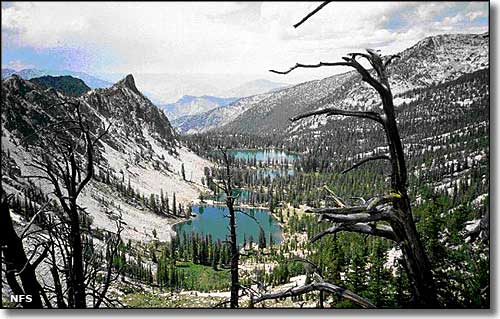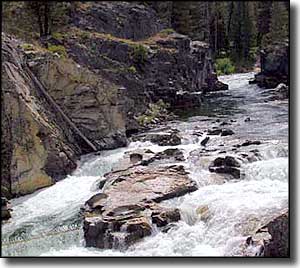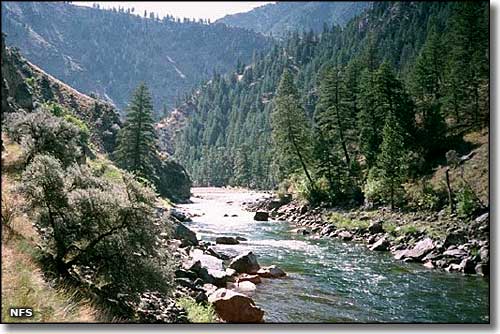 |
Frank Church-River of No Return Wilderness |
 In the Frank Church-River of No Return Wilderness |

The 2,366,757 acres of the Frank Church-River of No Return Wilderness make this the 2nd largest wilderness in the lower 48 states (only the Death Valley Wilderness in California is larger). This wilderness spans several national forests and includes the former Idaho Primitive Area, the Salmon Breaks Primitive Area and a chunk of land managed by the Bureau of Land Management. If you'd like to experience the closest thing there is to an Alaskan wilderness without going to Alaska, this is the place to go. This is a land of rugged mountains separated by deep canyons cut by clear-flowing rivers. There's also the Chamberlain Basin, a 500-square-mile rolling forested plateau. The Middle Fork of the Salmon River and the main Salmon River cut across this wilderness and provide 2 excellent streams of some of the finest whitewater adventure on Earth. For that matter, the main Salmon River is the original "River of No Return," and the canyon that it has cut into this landscape is as much as 6,300' deep, deeper even than the Grand Canyon of the Colorado River. Unlike the sheer cliff walls of the Grand Canyon, the canyons here are steep and heavily wooded as they rise to sharp ridges, eroded bluffs, castles, towers and solitary, ragged granite peaks. The Selway River also finds its headwaters in the Frank Church-River of No Return Wilderness before it flows north and into the Selway-Bitterroot Wilderness on its way to the Columbia River and then sea level. The Selway, the Middle Fork of the Salmon and a chunk of the main Salmon River are all designated "Wild and Scenic Rivers." The west and the southeast side of Frank Church-River of No Return Wilderness borders along the Salmon River Mountains and the southwest side along the Sawtooth Range with the Bighorn Crags rising in between on the south side. In the Bighorn Crags area you'll find 14 beautiful, crystal-clear lakes. The Frank Church-River of No Return Wilderness runs north from these mountains with the northern boundary against the Magruder Corridor (a 600' wide corridor along a dirt road that follows the Nez Perce Trail across Idaho and into Montana over Nez Perce Pass - the Magruder Corridor is all that separates the Frank Church-River of No Return Wilderness from the Selway-Bitterroot Wilderness). The northwest boundary of the Frank Church-River of No Return Wilderness is against the Gospel-Hump Wilderness. The lower reaches of the wilderness tend to be covered in thick Ponderosa pine forest, with lodgepole pine and Douglas fir rising above that into the spruce, fir and aspen zone of the upper elevations. Among the 370 different animal species identified in these woods you'll find lots of elk, mule deer, moose, black bear, gray wolf, coyote, wolverine, mountain goat, bighorn sheep, mountain lion, and some Canada lynx. The only large mammal that's missing from the area: the grizzly bear. In recent years, wildfires have been allowed to burn freely. That means tens of thousands of acres of the Frank Church-River of No Return Wilderness are covered with everything from the badly charred remains of old-growth pine, Douglas fir and spruce to lightly browned understory and rejuvenated grass slopes. While I'm on the subject, a word of warning: the "Frank" is justly famous for its large population of mountain lions... The trout fishing is world-class almost everywhere in the wilderness. The gray wolf was re-introduced to the Fank Church-River of No Return Wilderness beginning in 1995. 11 were released in January, 1995 and another 20 were released in January, 1996. Today, more than 400 gray wolves roam the "Frank", the Selway-Bitterroot and the Gospel Hump Wildernesses 
There's almost 2,616 miles of trails here, spread across 296 maintained (and semi-maintained) routes that use 114 bridges to cross rivers and streams. 32 different Forest Service roads give access to 66 trailheads that lead into this huge area. And even with these numbers, about 1.5 million acres of the wilderness are essentially trail-free. Part of the fun in the "Frank" is the lower elevations are in the 2,000' range, while the upper areas exceed 10,000'. On some "trails," you might find yourself climbing (and/or descending) up to 8,000' in just a few miles... There are several primitive airstrips that date back to before the Wilderness designation and small planes are still allowed to land at them. Parts of the main Salmon River allow jet boats. There's also 88 different outfitters licensed to provide backpacking, horsepacking, float and ski trips into the Frank Church-River of No Return Wilderness. There are many places in the wilderness where you'll come across evidence of the ancient Shoshone and Nez Perce inhabitants, and the remnants of places more recently occupied by fur trappers, missionaries, homesteaders and miners. Any artifacts that you come across are protected by the federal Antiquities Act, so look at them, enjoy them, then leave them where you found them for the next visitor to enjoy. Special regulations for the Frank Church-River of No Return Wilderness:
The 1980's saw an increase in wildfires on the "Frank," with a peak fire season happening in the heart of the drought in 2000. That year saw the first time the wilderness has been evacuated in its history. Some portions of the forest were burned completely to the ground. Because the heart of the drought continued in 2001, virtually no recovery was seen. By 2004, things started to get wet again and recovery started on a massive scale. As much "damage" as the fires did to the tree cover and wildlife, in the aftermath it has become obvious that the fires were necessary for the long-term health of the Wilderness. In the short term, though, because of all the dead snags still standing, hiking around in the burned areas can be quite hazardous, especially when the wind is blowing. Most human traffic in the Frank Church-River of No Return Wilderness confines itself to the Salmon and the Middle Fork of the Salmon Rivers, plus a couple of high mountain lake areas and the Bighorn Crags. Other than that, most use of the Wilderness is done by big game hunters in the fall. |
 The Salmon River in the Frank Church-River of No Return Wilderness |
|
|
 |
| Index - Arizona - Colorado - Idaho - Montana - Nevada - New Mexico - Utah - Wyoming National Forests - National Parks - Scenic Byways - Ski & Snowboard Areas - BLM Sites Wilderness Areas - National Wildlife Refuges - National Trails - Rural Life Advertise With Us - About This Site - Privacy Policy |
| Photos of the Frank Church-River of No Return Wilderness courtesy of the National Forest Service. Text Copyright © by Sangres.com. All rights reserved. |